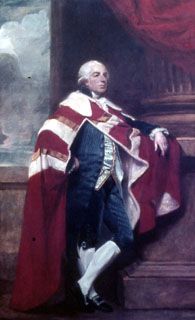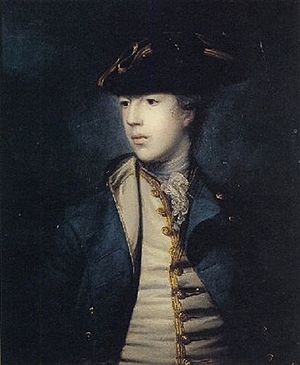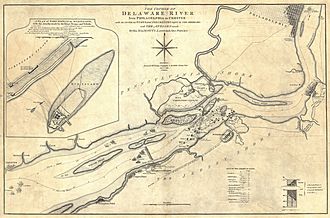Francis Reynolds-Moreton, 3rd Baron Ducie facts for kids
Quick facts for kids
Baron Ducie
|
|
|---|---|

Portrait by George Romney
|
|
| Born |
Francis Reynolds
28 March 1739 Strangeways, Manchester
|
| Died | 20 August 1808 (aged 69) |
| Known for | British Royal Navy Commodore at the Battle of Red Bank |
Francis Reynolds-Moreton, 3rd Baron Ducie (born March 28, 1739 – died August 20, 1808) was an important British naval officer. He later became a politician. He commanded several ships before, during, and after the American Revolutionary War. He is best known for his role in the Revolutionary War at the Battle of Red Bank in 1777. This battle was part of the Philadelphia campaign on the Delaware River. It involved attacks on Fort Mifflin and Fort Mercer.
During this time, he commanded the lead fleet on his ship, HMS Augusta. His goal was to clear the way along the Delaware River to Philadelphia. His ship got stuck and then mysteriously caught fire. It exploded before all the crew could escape. Reynolds also commanded HMS Jupiter and HMS Monarch. He served in battles against the French in the North Sea, the European Atlantic coast, and the Caribbean.
Contents
Early Life and Family
Francis Reynolds was born in Strangeways, Manchester, England. He was baptized on June 25, 1739. His family, the Ducies, came from Normandy. His parents were Francis Reynold and Elizabeth Moreton. In 1757, he became an Esquire, a title of respect.
He married twice. In 1774, he married Mary Purvis. They had two sons: Thomas, who would inherit his title, and Augustus John, who became a Lieutenant colonel in the army. After Mary passed away, he married Sarah Child in 1791. She was the widow of a London banker. Francis took the last name Moreton in 1786. His brother, Thomas Reynolds, was the second Baron Ducie of Tortworth.
A Career at Sea

Francis Reynolds began his naval career as a midshipman. This was a junior officer rank. He passed his Lieutenant's exam on April 27, 1758, when he was 19. The very next day, he became a Lieutenant. By November 21, 1760, he was promoted to Commander.
His first known service was in April 1752. During the Seven Years' War, Reynolds took command of HMS Weazel. He later became a Post Captain on April 12, 1762. This was a high rank for a naval officer.
In April 1762, Reynolds was made captain of HMS Ludlow Castle, a ship with 44 guns. He then joined the smaller ship HMS Garland, which had 24 guns. This ship sailed off the coast of France and later went on a voyage to Africa.
The American Revolutionary War

Reynolds was the commander of HMS Augusta. This was a large warship called a ship of the line with 64 guns. His ship was part of the British fleet trying to reach Philadelphia during the American Revolutionary War. The Americans had built two new forts, Fort Mifflin and Fort Mercer. These forts stopped British ships from bringing supplies to their troops in Philadelphia via the Delaware River.
On October 12, 1777, General Howe ordered his forces to capture these forts. British cannons on the Pennsylvania side of the river fired at Fort Mifflin. At the same time, Colonel Carl von Donop led about 2,000 Hessian soldiers to attack Fort Mercer on the New Jersey side.
As this was happening, Reynolds' fleet moved up the river. Their goal was to bombard both Fort Mercer and Fort Mifflin. They also wanted to draw American ships away from supporting the Hessian attack. However, Reynolds' fleet and von Donop's land forces could not communicate. This made their efforts less effective.
The American fleet, led by Commodore Hazelwood, immediately attacked Reynolds' ships. This forced Reynolds to pull back down the river. As the river tide went out, Reynolds' ship, the Augusta, and another ship, HMS Merlin, got stuck on a sandbar. They were trying to go around obstacles placed in the river. The Augusta was tilted on its side.
While being attacked by Hazelwood's fleet, Reynolds tried to lighten his ship by removing supplies. This was to free it from the sandbar. But a fire broke out below deck and spread quickly. Reynolds and his crew had to abandon the ship. Shortly after noon, the fire reached the powder magazine. The Augusta exploded with great force, killing some crew members. The explosion was so loud it could be heard 30 miles away! Before leaving, Reynolds ordered the Merlin to be set on fire to prevent the Americans from capturing it. The loss of the Augusta was a big surprise and very upsetting for the British commanders.
After the battle, Reynolds faced a court-martial. This is a military trial. It happened a month later, on November 26. Captain Reynolds testified that he followed Admiral Richard Howe's orders to help the Hessians. He was found not guilty of losing the Augusta.
Other Important Battles
Reynolds took command of HMS Jupiter, a ship with 50 guns, in July 1778. On October 20, he chased a large French warship called the Triton. After a long chase, a fierce battle began in stormy weather. The battle lasted two hours. The Triton had many casualties, but the darkness and rough seas stopped Reynolds from winning completely.
In September 1780, Reynolds took command of HMS Monarch, a ship with 74 guns. He sailed to the West Indies. He was present at the Capture of Sint Eustatius in February 1781. He was chosen to chase a Dutch ship called the Mars. On February 4, Reynolds fought the Mars and forced it to surrender. The senior Dutch officer was killed in this action.
Reynolds continued to serve with distinction. He was part of the fleet at the Battle of the Chesapeake in 1781. This was a very important naval battle during the American Revolutionary War. He also fought at the Battle of Saint Kitts in January 1782 and the Battle of the Saintes in April 1782.
Later Life
After his naval career, Francis Reynolds-Moreton became involved in politics. On September 9, 1785, he was elected as a Member of Parliament for Lancaster, Lancashire. Just two days later, on September 11, 1785, he inherited the title of Baron Ducie from his older brother. This meant he became a member of the House of Lords. He later became the Clerk of the Crown in County Palatine of Lancaster.
An island in the Pacific Ocean, called Ducie Island, was named after him. Captain Edward Edwards named it. Edwards had served under Baron Ducie when he commanded the Augusta.
See also
- Tadeusz Kościuszko, designer and engineer of Fort Mercer
- Fort Billingsport, Revolutionary War era fort on the Delaware River
- List of American Revolutionary War battles
- List of nautical terms

